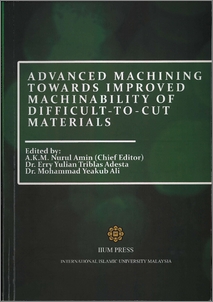Amin, A. K. M. Nurul and Mahmoud, Asif
(2011)
Development of a mathematical model for the prediction of surface roughness in end milling of stainless steel SS 304.
In:
Advanced Machining Towards Improved Machinability of Difficult-to-Cut Materials.
IIUM Press, Kuala Lumpur, Malaysia, pp. 133-142.
ISBN 9789674181758
![[img]](http://irep.iium.edu.my/style/images/fileicons/application_pdf.png)  Preview |
|
PDF ( Development of a mathematical model for the prediction of surface roughness in end milling of stainless steel SS 304)
- Published Version
Download (567kB)
| Preview
|
Abstract
The use of advanced computer-based systems for the selection of optimum conditions of
mechanical components during process planning becomes essential for today’s complex
products. Computer aided manufacturing (CAM) has widely been implemented to obtain more
accurate machining data and to ensure that optimum production is achieved. Machinability of a
material provides an indication of its adaptability to be manufactured by a machining process. In
general, machinability can be defined as an optimal combination of factors such as low cutting
force, high material removal rate, good surface integrity, accurate and consistent workpiece
geometrical characteristics, low tool wear rate and good curl or breakdown of chips.
In machinability studies investigations, statistical design of experiments is used quite
extensively. Statistical design of experiments refers to the process of planning the experiment so
that the appropriate data can be analyzed by statistical methods, resulting in valid and objective
conclusions [1]. Design and methods such as factorial design, response surface methodology
(RSM) and Taguchi methods are now widely use in place of one-factor-at-a-time experimental
approach which is time consuming and exorbitant in cost. A machinability model may be defined
as a functional relationship between the input of independent cutting variables (speed, feed,
depth of cut) and the output known as responses (tool life, surface roughness, cutting force, etc)
of a machining process [2]. Response surface methodology (RSM) is a combination of
experimental and regression analysis and statistical inference. RSM is a dynamic and foremost
important tool of design of experiment (DOE), wherein the relationship between response(s) of a
process with its input decision variables is mapped to achieve the objective of maximization or
minimization of the response properties [3]. Many machining researchers have used response
surface methodology to design their experiments and assess results. Kaye et al [4] used response
surface methodology in predicting tool flank wear using spindle speed change. A unique model
has been developed which predicts tool flank wear, based on the spindle speed change, provided the initial flank wear at the beginning of the normal cutting stage is known. An empirical
equation has also been derived for calculating the initial flank wear, given the speed, feed rate,
depth of cut and workpiece hardness. Alauddin et al [5] applied response surface methodology to
optimize the surface finish in end milling of Inconel 718 under dry condition
A dimensional-accuracy model for the peripheral milling of aluminum alloys under dry and
down-milling conditions was presented by Fuh and Chang [6]. Gu et al. [7] presented a new
model for the prediction of surface flatness errors in face milling. Their method called equivalent
flexibility influence coefficient method. In this chapter, the technique is used to develop a
mathematical model that utilizes the response surface roughness methodology and method of
experiments to predict the surface roughness when milling stainless steel SS 304 using TiN
coated Tungsten carbide inserts.
Actions (login required)
 |
View Item |


 Download Statistics
Download Statistics Download Statistics
Download Statistics